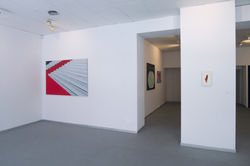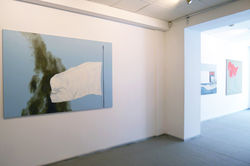WIKTOR DYNDO



110 x 190 cm, oil/canvas

A Thousand and One Nigts,_Allahu Akbar, 110 x 190 cm, oil/canvas

35 x 45 cm, oil/canvas

110 x 190 cm, oil/canvas
NEWS
"Lejanias”.
Modern Art from Krzysztof Musial Collection, Centre del Carme , Valencia, Spain



"Manhattan Gallery 25 years of activity"
editor Magdalena Milewska
©Poleski Ośrodek Sztuki
Łódź 2017

"Game Over" painting joins the collection of the National Museum in Gdansk
XY
Opening: 17 June 2017, 4 pm
Exhibition continues : 17 June‒20 August 2017
The MODEM Center for Modern and Contemporary Arts
Baltazár Dezső tér 1, Debrecen, Hungary

©MODEM

©MODEM

XOXOXO
Opening: 12.05.2017
Exhibition continues 15.05‒02.06. 2017 (MON‒FRI 12pm‒6pm)
Galeria Salon Akademii
Academy of Fine Arts in Warsaw
Krakowskie Przedmieście Str. 5
The exhibition analyzes the way in which media, and the Internet in particular, influence the construction of contemporary identities. Becoming part of our personalities, they enable us to incorporate elements of the foreign into ourselves.
In the rooms of the Salon Akademii gallery in Warsaw, eight selected artists present their new, hitherto unexhibited works. Some of them refer to different ‘tribes’ inhabiting the Internet, focusing on the phenomenon of celebrities and their psychofans (Aleksandra Natalia Koper, Sonja Orlewicz), or the culture of the so-called squatting Slavs (Princ Polo, Rafał Dominik). Others analyze the way in which digital media create ‘facts’ and represent politicians, in an incessant and infinite circulation of images (Bean Gilsdorf, Wiktor Dyndo). Finally, works by Izabella Bryzek and Barbara Łuczkowiak bring to the limelight the need to travel, with all the curiosity, first-hand experience and ‘xenophilia’ involved – an idea still valid in the times when even the most remote corners of land (and the universe) are just ‘one click away.’
The title of the exhibition refers to the positive energy of ‘hugs and kisses’ we send in Internet conversations. This optimistic connotation also plays with the sonic aspects of the prefixes ‘exo’ and ‘xeno’ – denoting the things that are different, strange, and exotic, suggesting our attitude towards them.
Participating artists: Izabella Bryzek, Rafał Dominik, Wiktor Dyndo, Bean Gilsdorf, Aleksandra Natalia Koper, Barbara Łuczkowiak, Sonja Orlewicz, Princ Polo
Curator: Klara Czerniewska-Andryszczyk

The catalogue of the exhibition
Part of a panting "Boom", on a poster to a play "Quay West" by Bernard-Marie Koltès
directed by Kuba Kowalski, Żeromski Theatre, Kielce, Poland
THE DRAWERS vol. 2
01.09-15.09 2016
Kasia Michalski Gallery
ul. Poznańska 16, Warszawa
Kasia Michalski Gallery is delighted to present its second edition of The Drawers project, opening the gallery’s cultural season before the Warsaw Gallery Weekend held on 23-25 September.
The uniqueness of the show’s format, initiated in 2015, continues to be based on a standard piece of gallery furniture which holds nine drawers. Each drawer contains works by one artist only, and only one drawer can be opened at a time. As a result, nine small-scale, ephemeral solo shows emerge, encouraging the audience to interact with each individual presentation.
While the last year’s edition played with the physical limits of the drawers themselves, the exhibition this year presents works by nine emerging Polish artists who take this idea further. Franciszek Buchner, Norbert Delman, Jan Domicz, Jacek Doroszenko, Wiktor Dyndo, Jacek Kołodziejski, Maciej Ratajski, Gregor Różański, and Piotr Rymer were asked not only to submit projects constrained by the 144 x 49 x 4.3 cm format of a single drawer, but also were encouraged to create works that could be presented in the main gallery space, which thus enabled them to develop their projects in more depth, and to demonstrate their individual styles and manifold interests in more detail.
The works, in vast majority created specially for the show, engage a diversity of media, from painting and sculpture to various multimedia projections and installations. Some of the artists, as in the case of Franciszek Buchner, Maciej Ratajski or Piotr Rymer, play with the site-specificity of the place of display, while others, like Jan Domicz and Jacek Kołodziejski, allude to our perception of art as a commodity and our desire to possess it. While Jacek Doroszenko explores the theme of visual sonorities, others, such as Norbert Delman, Gregor Różański and Wiktor Dyndo, question current political and media-related behaviors, shedding light on various forms of oppression and on the Internet’s artificiality.
Although the exhibition lasts only for two weeks, the pieces displayed in the chest of drawers will remain accessible to public after that period.

©Kasia Michalski Gallery

©Kasia Michalski Gallery
Wiktor Dyndo
The Truth Lies at the Bottom of an Oil Well
08.07-02.09 2016
Galeria Manhattan
118 Piotrkowska St., Łódź
The title of the exhibition The Truth Lies at the Bottom of an Oil Well is a travesty of an English proverb which places the truth at the bottom of a well. This meaningful modification makes it possible to describe in one sentence the supposed source of the conflicts in the Middle East – it is all about business.
From everywhere come to us the signals of the dramatic events in East Asia and North Africa as well as at the coast of the European continent. Because of the recent “migration period” this oriental world has suddenly become very close to us, too close for some.Wiktor Dyndo's paintings show this exoticism, but at the same time are extremely reserved in passing judgements. They play the most important role attributed to painting – they simply represent.
In his paintings the artist shows politics, but not in the manner we got accustomed to by dealing with the contemporary media. The sides of conflicts and important players on the international stage are presented in his works solely by means of symbols, national colours, the shapes of countries. Nothing is said directly, what matters is the polysemy of reception. Even the explosions, which at times appear on the canvas, lack the dramatic nature; the main actors of the drama are absent; poignant emptiness and anxiety can be sensed everywhere.
The stronger the political propaganda is orientated against people's convictions, the more it reinforces the resistance. These are the words of an outstanding Polish Islamist and Arabist Prof. Janusz Danecki. In other words, the more we convince somebody of something, the less credible we become and we go against ourselves. Only telling the truth works.
So what is the truth that Wiktor Dyndo shows through his paintings? A spare, almost schematic way of showing the fragment of reality casts the artist in a role of an impersonal but careful observer. Dyndo shows facts, but he does not take sides. This is something a spectator must do in his or her conscience.
The world in Dyndo's paintings is usually uninhabited. No one is standing there with the majestic flags in the background, so no one is responsible for the decisions made at the top level; there are no terrorists, so no one is guilty of the attacks; there are no victims, so no one is the injured party. This shows that the truth seems to be more complex than we think.
Looking at the artist's paintings we experience momentary peace of mind. We see pictures with bright and vivid colours, devoid of too many details; they do not weary, even calm nerves. The passage from the comfort zone to reflection takes no time. After a moment, the mood changes diametrically.
The beautiful, dignified flags turn out to have the flagstaffs ended with shiny, albeit slightly ominously sharpened tips; moreover, some of them prove to be unstable; the soothing blue of the sky is cut by a black, smoking band which spells disaster; in the shape of an idyllic country there festers a black wound; everyday objects such as a security gate are dressed in a characteristic keffiyeh motif and the diamond, in its bloody version, ceases to be the symbol of gloss, wealth and living in luxury - it shows what kind of dramatic events are necessary to pay for its extraction. Spectators quickly realize that all these scenes reflect their modern fears and anxieties. Although the artist does not identify with them, he appears to understand or at least notice and ruthlessly highlight them.
Magda Milewska
 |  |  |
|---|---|---|
 |  |  |
 |  |







